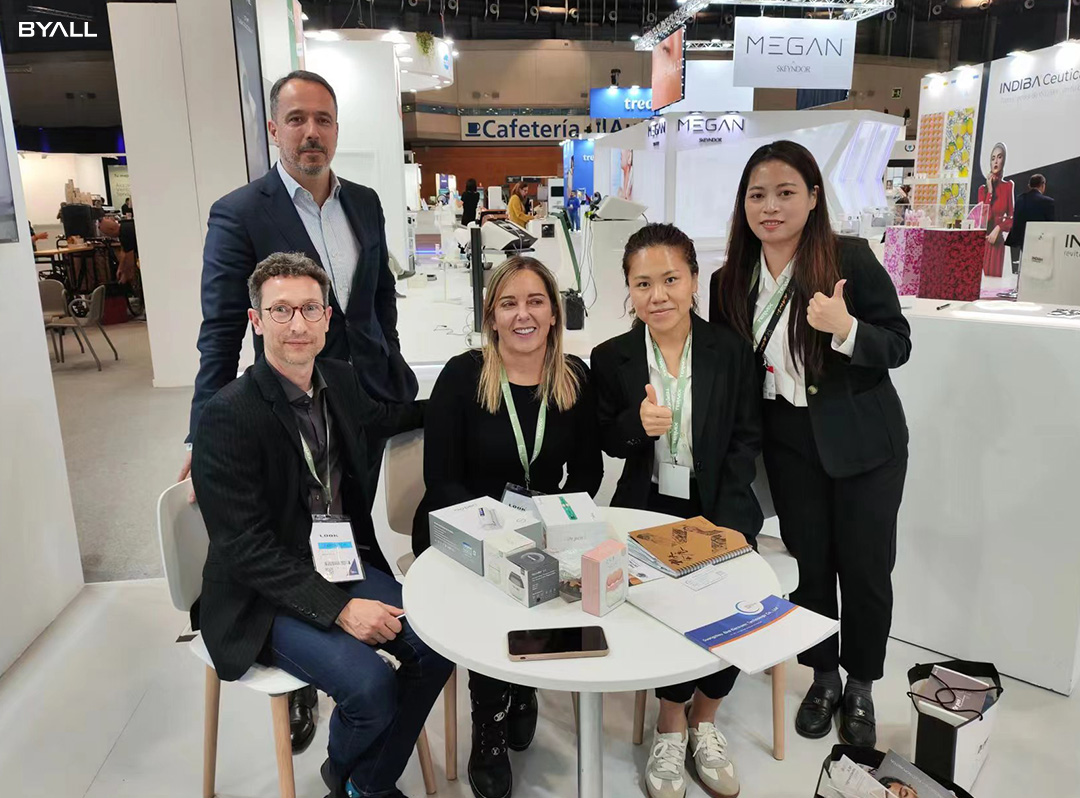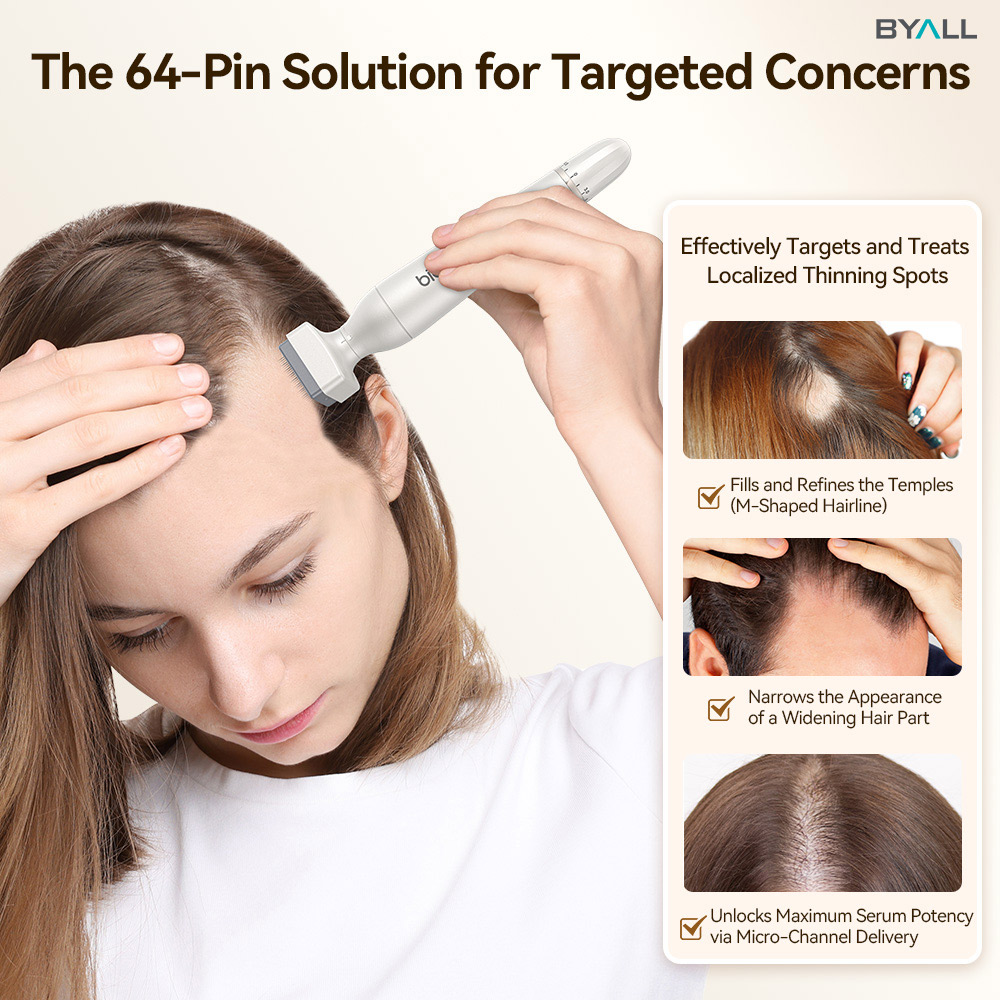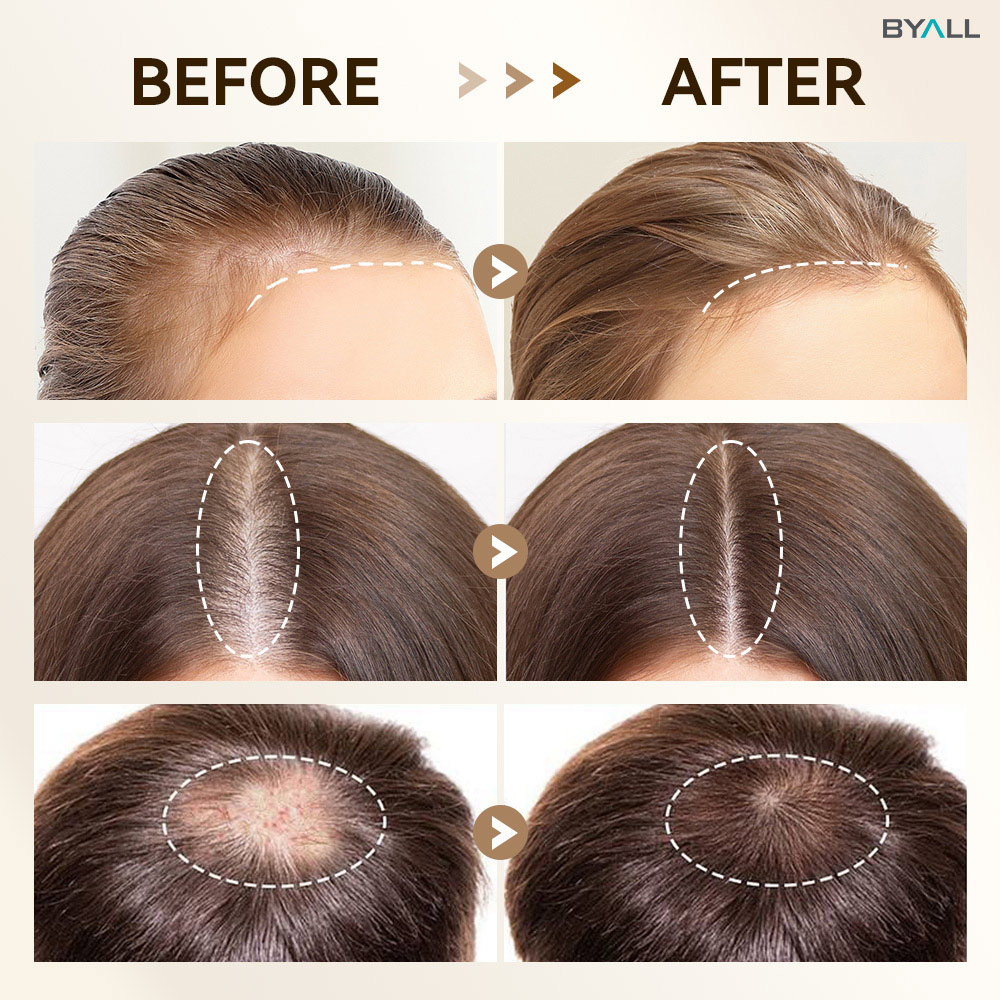In the past five years, microneedling has witnessed an explosive surge in popularity, especially among those battling hair loss.
Recent studies indicate that microneedling can boost hair count by up to 15%.

With mounting clinical evidence and a growing array of consumer devices—from microneedling rollers and stamps to automated devices with needle lengths ranging from 0.25 mm to 2.5 mm (or even higher)—the question remains: What is the optimal needle length for treating hair loss?
Is it 0.25 mm, 0.5 mm, 1.0 mm, 1.5 mm, 2.0 mm, or higher? Despite what microneedling manufacturers may claim, there’s no definitive answer. Instead, the right needle length is highly contextual, depending on
(1) how frequently you plan to undergo microneedling treatments?
(2) whether you’re combining microneedling with other therapies
This article delves into the research to uncover the evidence and offers guidance on how to best position yourself for hair regeneration if you decide to embark on microneedling treatment.
What is Microneedling?

Microneedling is a stimulation-based hair loss therapy.
Similar to platelet-rich plasma (PRP) therapy and scalp massage, microneedling induces acute injury to the balding scalp skin (via medical-grade needles) to elicit growth factors.
Over time, these growth factors may help
(1) promote the formation of new blood vessels,
(2) reduce the appearance of scar tissue
(3) stimulate hair follicle proliferation.
Yes, the treatment can be painful, and microneedling devices may resemble medieval torture instruments.
However, despite the discomfort, microneedling treatments—repeated once or twice weekly for 3-6 months—have been shown to significantly improve hair growth in men with androgenetic alopecia (AGA).
Microneedling Needle Length: Depth Matters for Hair Follicle Impact

Our scalp skin consists of three primary layers: the epidermis, dermis, and subcutaneous tissue (or hypodermis).
The thickness of our scalp (and its components) is influenced by age, gender, and degree of baldness, but generally, our scalp is only 5-6 mm thick.
Within the skin, the epidermis is typically less than 0.5 mm thick, the dermis is 1-2 mm thick, and the subcutaneous layer is 3 mm thick.
This is crucial when considering microneedling needle lengths because the depth to which these needles penetrate our scalp directly affects which areas of the hair follicles we stimulate.
0.25 mm to 0.5 mm Needle Length: Enhancing Local Absorption
At shorter needle depths (0.25 mm to 0.5 mm), microneedling only injures the superficial layer of the skin (epidermis). This improves the absorption of topical medications (such as minoxidil). However, these shallower depths may not elicit the growth factors necessary to promote hair follicle proliferation. To achieve this effect, we need to create deeper wounds—specifically, we need to reach the dermis.1.5 mm to 2.5 mm Needle Length: Triggering Hair Follicle Proliferation
At longer needle depths (1.5 mm to 2.5 mm), microneedling needles penetrate the dermis of our scalp skin. This has a significant impact on hair follicle proliferation because the dermis is where the hair follicle stem cell bulge is located. It’s also where the vascular network resides—hence, punctures at this depth often result in swelling and/or pinpoint bleeding.
What is the Hair Follicle Stem Cell Bulge?
The hair follicle stem cell bulge is situated 1.0 mm to 1.8 mm deep in the scalp skin, near the follicular isthmus (upper third)—typically found at the base of the arrector pili muscle.

This bulge acts as the “raw material” for hair follicles. These stem cells help replenish and refill the cells that make up each hair follicle.
If the stem cell population within a hair follicle is completely depleted, the follicle can no longer replace old cells and will cease to proliferate (or grow).
Interestingly, we can stimulate these stem cells through wounding. If wounds occur around these stem cell bulges, the growth factors stimulated during the wounding process can even signal these hair follicle stem cells to initiate a new anagen phase of the hair cycle.
How to Use Microneedling on the Scalp: A Step-by-Step Guide
1.Selecting the Right Microneedling Cartridge for Your Scalp
The first step in a microneedling regimen is choosing the appropriate needle.
For instance, Dr. Pen’s microneedling pens come with various needle cartridges to suit different treatments. Options range from 11-needle to 48-needle cartridges.
For scalp microneedling treatment, it’s recommended to use cartridges with a higher number of needles: 24-needle or 36-needle cartridges are ideal for scalp skin.
For scalp treatment, needle lengths between 0.5 mm and 1.5 mm are optimal. If you’re regularly using hair growth serums, a 0.5 mm needle can enhance the absorption of local treatments.
Conversely, if you aim to stimulate deeper scalp layers to promote hair growth through microneedling, you can use needles ranging from 1.0 mm to 1.5 mm.
2.Preparing for Microneedling
Before starting microneedling treatment, thoroughly cleansing your scalp is crucial to prevent infection.
If you’re concerned about pain, you can apply an anesthetic cream before the procedure.
3.Microneedling Scalp Therapy
A single session should last 10-20 minutes, depending on the scalp area you’re treating.
During this treatment, you can also use hyaluronic acid or hair repair serums to enhance the effects of microneedling.
To begin microneedling, move the device in a grid-like pattern across your scalp. Avoid applying excessive pressure and ensure you cover all areas of thinning hair.
When performing microneedling on your scalp, follow these important precautions:
- Maintain Cleanliness: Always ensure your device and work area are clean to avoid cross-contamination.
- Take It Slow: Start with shorter needles and gradually increase the length as your scalp becomes accustomed to the process.
- Avoid Excessive Pressure: Applying too much pressure can cause irritation, inflammation, and even damage to your scalp.
- Don’t Ignore Pain or Discomfort: While microneedling may cause mild discomfort, severe pain or prolonged irritation is not normal. If you experience these symptoms, consult a professional.
4.Post-Microneedling Scalp Care
It’s advisable to avoid washing your hair for at least 4 hours after treatment.
It’s also important to avoid using scalp products containing artificial fragrances for several days post-treatment.

In the days following treatment, you may notice peeling on your scalp, similar to the peeling that occurs after a mild sunburn.
This is a normal reaction as the top layer of your scalp renews itself. Your scalp may also feel tender or sore.
Given that microneedling causes numerous micro-injuries, this is perfectly normal.
If you notice persistent inflammation in a specific area, be sure to thoroughly disinfect it with an antiseptic like iodine before bed.
Avoid exposing your freshly treated scalp to direct sunlight, as this can cause adverse reactions.
Just as our skin is more susceptible to sunburn after exfoliation, the same applies here.

Wearing a hat or headscarf during this recovery period can help protect your scalp.
Avoid strenuous exercise, as this can cause your scalp to sweat.
During the healing process, your scalp is more vulnerable to bacterial and dirt infections.
Finally, sleeping on a clean pillowcase can also help prevent potential infections.
Basic Post-Treatment Care
It’s important to remember that there’s no one-size-fits-all solution for hair loss.
Additional supportive care is also a beneficial factor in the success of scalp microneedling treatment.
For example, regularly using an LED light therapy device on your scalp can speed up the healing process while increasing stimulation for hair growth.
Some successful cases also involve regularly applying minoxidil to the scalp.
Bio4 Professional Dual-Head Microneedle System: Revolutionizing Hair Restoration with Precision and Versatility
In the ever-evolving world of professional hair care and restoration, innovation is key to staying ahead.
The Bio4 Professional Dual-Head Microneedle System is a game-changer, offering salons and clinicians a cutting-edge tool that combines two specialized microneedle heads in one ergonomic handle for unparalleled treatment flexibility and results.
With its “One Handle, Two Solutions, Complete Coverage” design, the Bio4 empowers professionals to address a wide range of hair and scalp concerns—from full-scalp density improvement to delicate hairline refinement—all with a single, cost-effective device.
Dual-Head Design: The Best of Both Worlds
1. 120-Needle Rectangular Head – Maximum Coverage for Full-Scalp Treatments
The 120-needle rectangular head is engineered for large-area coverage, making it ideal for:
- Full-scalp microneedling to stimulate overall hair growth
- Boosting hair density across the entire scalp
- Even distribution of serums and treatments for optimal absorption
Its optimized needle arrangement ensures maximum efficiency, allowing professionals to cover more ground in less time while delivering consistent, effective results.
2. 64-Needle Square Head – Precision Targeting for Delicate Areas
The 64-needle square head provides unmatched precision for targeted treatments, including:
- Hairline restoration and refinement for a natural, defined look
- Parting line enhancement to create a flawless, camera-ready finish
- Scar tissue treatment to improve scalp health and promote regrowth
- Localized hair loss correction in problem areas
Its square formation ensures enhanced control, making it perfect for intricate work around the temples, crown, and other delicate zones.
Key Applications for Professional Salons
The Bio4 Dual-Head Microneedle System is a versatile solution for a variety of hair restoration needs:
- Hairline Restoration & Refinement: Achieve a softer, more natural hairline with precision microneedling.
- Parting Line Enhancement: Perfect for clients seeking a polished, professional appearance.
- Scar Tissue Treatment: Helps improve blood circulation and nutrient delivery to damaged areas.
- Localized Hair Loss Correction: Target thinning patches with focused therapy for visible regrowth.
Why Bio4 is a Must-Have for Professional Salons
1. Expand Your Service Offerings with One Device
Instead of investing in multiple tools for different treatments, the Bio4 provides two specialized heads in one compact, easy-to-use system. This means salons can offer:
- Full-scalp rejuvenation
- Hairline sculpting
- Scar revision therapy
- Spot treatments for hair loss
All without cluttering their workspace or overcomplicating their service menu.
2. Reduce Equipment Investment Costs
By consolidating two essential treatments into one device, salons can save on purchasing, maintenance, and storage costs. The Bio4’s durable, high-quality construction ensures long-term reliability, making it a smart investment for any professional setting.
3. Increase Treatment Efficiency
The ergonomic handle and interchangeable heads allow for seamless transitions between treatments, reducing downtime and improving workflow. Professionals can switch from full-scalp coverage to precision targeting in seconds, maximizing productivity without sacrificing quality.
4. Enhance Client Satisfaction
Clients expect fast, visible results from their hair restoration treatments. The Bio4 delivers:
- Faster healing and recovery due to minimal scalp trauma
- More natural-looking outcomes with precise needle placement
- Customizable treatments tailored to individual needs
This leads to higher satisfaction rates, repeat business, and glowing referrals.
The Bio4 Professional Dual-Head Microneedle System is more than just a tool—it’s a complete solution for salons and clinicians looking to elevate their hair restoration services.
With its dual-head design, precision targeting, and cost-effective benefits, it’s the perfect addition to any professional arsenal.
When Can You Expect Results from Scalp Microneedling Treatment?
Consistency is key when it comes to scalp microneedling treatment.
The recommended average treatment frequency is as follows:
Begin scalp microneedling treatments once a week during the first month; gradually increase to twice a week during the second month.
Afterward, you can continue with monthly scalp microneedling treatments to maintain the results.

Although results may vary, most microneedling users can see positive effects on hair growth within the first three to six months.
This is the suggested general treatment plan because it allows the scalp’s healing process to complete thoroughly, enabling you to accurately assess the results.
Remember, this is a general guide, so consult your healthcare professional for the best hair loss treatment outcomes.
Conclusion
We hope this blog has prepared you for your next scalp microneedling treatment and answered some questions about starting microneedling for hair loss.
If you’re new to microneedling, consider exploring your potential first Dr. Pen microneedling pen, which is suitable for scalp microneedling treatment as well as other skin concerns like fine lines, wrinkles, and skin texture. Need help or have questions?
Visit our website to chat online with our friendly customer support team.
Join us on this exciting journey and experience the Dr.pen difference for yourself!

Choose Byall and experience the difference for yourself.
Partner with us today and let us help you take your beauty and skincare brand to new heights of success.
For more information on our microneedling pens, visit the Dr. Pen comparison page or contact our knowledgeable customer service.
For the Dealers and Distributors, please don’t hesitate to contact us to get a direct factory price today!
![]() Read Also: The Ultimate Guidance of Nanoneedling Treatment
Read Also: The Ultimate Guidance of Nanoneedling Treatment
![]() Read Also: Top 3 Highly Esteemed Professional Microneedling Pens Approved by Authorities
Read Also: Top 3 Highly Esteemed Professional Microneedling Pens Approved by Authorities
![]() Read Also: The Comprehensive Comparison about 3 Highly – rated Microneedling Pen Brands
Read Also: The Comprehensive Comparison about 3 Highly – rated Microneedling Pen Brands
![]() Read Also: Why Byall Is the Top Choice for Licensed Estheticians
Read Also: Why Byall Is the Top Choice for Licensed Estheticians
![]() Read Also:Unrivaled Advantages for Dr.pen Distributors with Byall
Read Also:Unrivaled Advantages for Dr.pen Distributors with Byall







